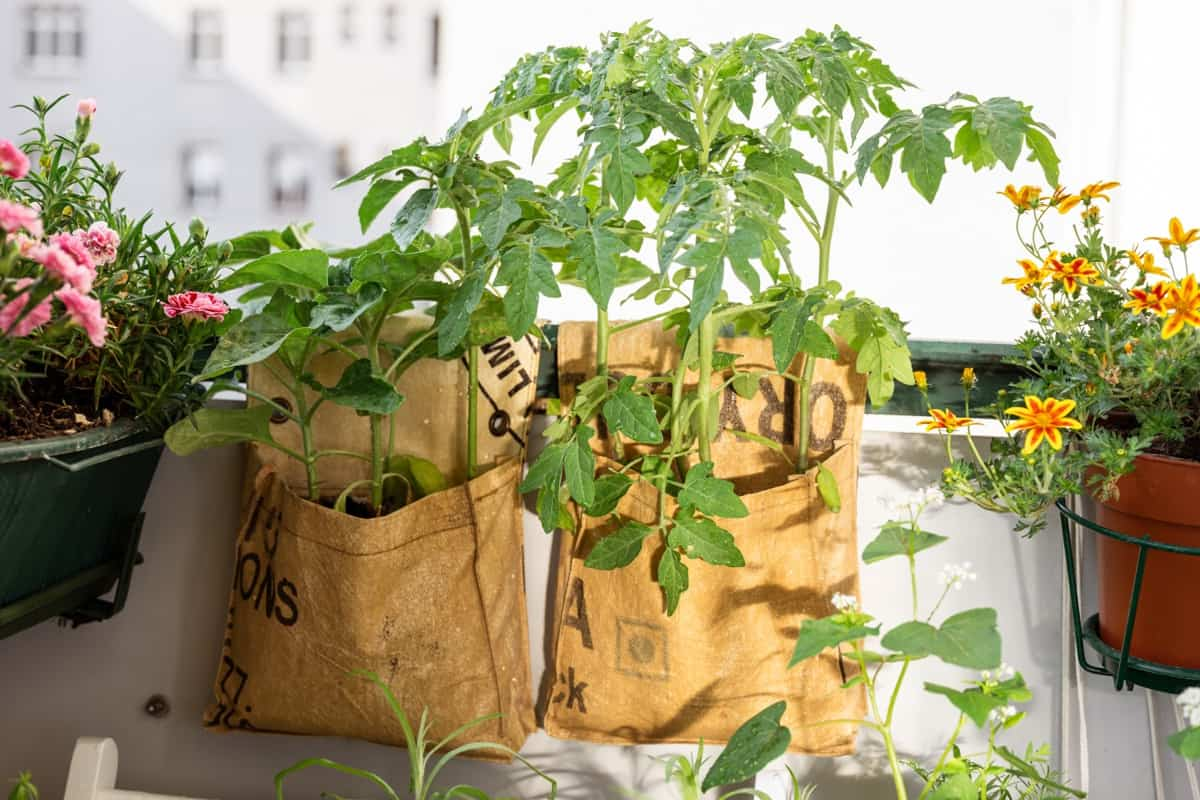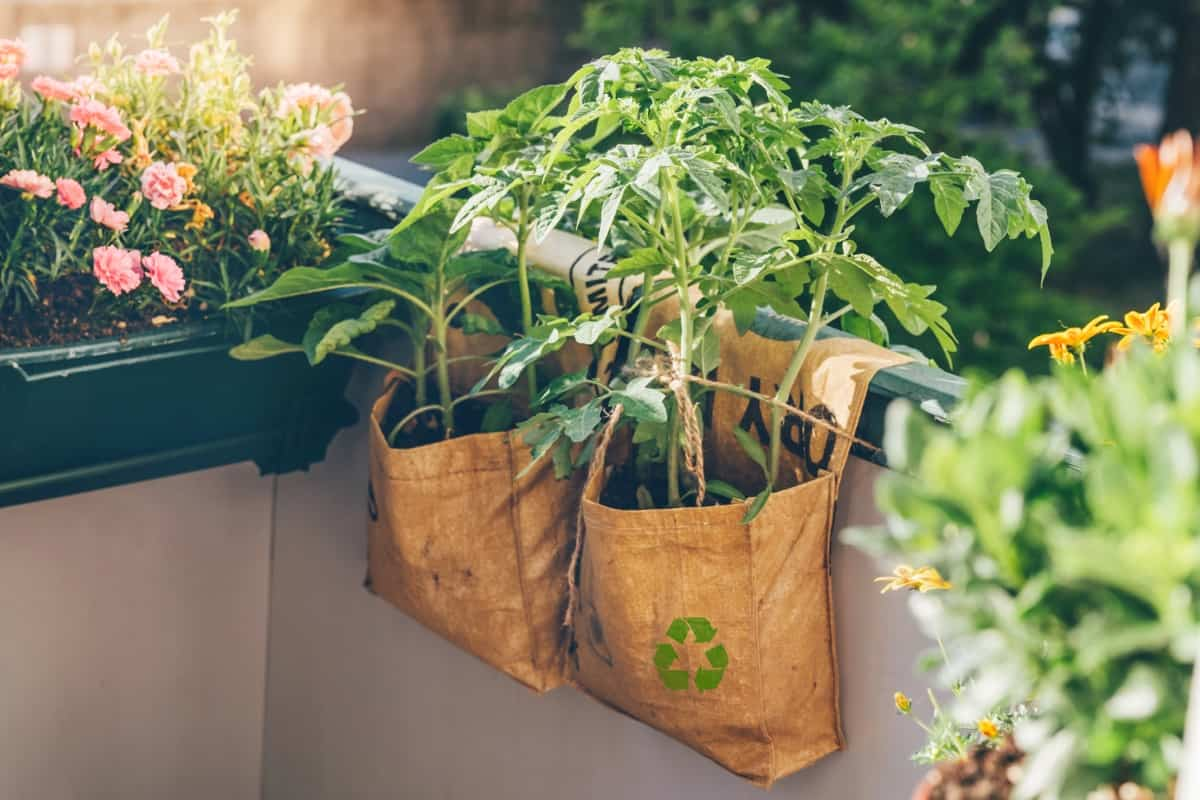Grow bags are a practical option for urban gardeners because they can use limited space, but any gardener can benefit from using them. Grow bags come in a broad range of sizes and shapes, and unlike big terra cotta pots, they take less strength to maintain. Below we learn about growing plants and vegetables in grow bags on the terrace, grow bag garden ideas, and simple steps to growing a plant in a grow bag.

How to grow plants in grow bags on terrace
Why use grow bags?
The term “grow bag” refers to a big, fabric-like bag that can cultivate plants and vegetables. In addition to plastic, they can also be found in several permeable materials. Grow bags are ideal for plants that don’t need a lot of soil, such as tomatoes, onions, salad greens, herbs, and peppers. Any plant grown in a pot can be grown in a grow bag and vice versa. Additionally, grow bags are the way to go if you need a spot for an in-ground garden. They look great lined up on a raised garden bed and are perfect for use on a terrace.0
Steps to grow plants in grow bags
Choose the right grow bags for your terrace garden
Size is an important factor when choosing to grow bags for terrace gardening. Choose a size appropriate for the type of plant you want to grow and the available space. For example, if you have limited space, choose smaller grow bags or place multiple bags side by side to maximize your growing area. If you have a large terrace and want to grow large plants, opt for larger grow bags to provide enough room for the roots to expand and develop.
The material of the grow bags is another important consideration. Fabric grow bags are breathable and allow for better aeration of the roots. Plastic grow bags are more durable and suitable for areas with harsher weather conditions, but they can retain heat and moisture, which can harm the plants if not appropriately managed. Biodegradable grow bags are environmentally friendly and can be broken down over time but may not be as durable as other options.
It is also essential to choose to grow bags with good drainage to ensure that excess water can escape and prevent root rot. Look for bags with multiple holes or slits and ensure they are designed explicitly for terrace gardening, as these will be better suited to the challenges of a rooftop or balcony environment.
How do you prepare the soil for a grow bag?
The soil in grow bags should be porous and hold just enough water so the plant’s root system doesn’t dry out completely between waterings. But, again, your best bet is container mixes and potting soils sold in bags. Coir (coconut fiber) is increasingly used in place of peat moss in potting soil mixtures. In addition, there is perlite, which resembles tiny pieces of styrofoam but is a white bead.
Perlite is a lightweight mineral that helps potting mix maintain moisture. Finally, Vermiculite, which is also flaky and similar to perlite, might be used in the mixture. Wood fines, ground-up wood, can also be included in bagged mixes. If no soil-borne diseases have entered your grow bag, there is no need to replace the soil every year. Instead, determine what caused the plant diseases. You will learn whether the germs are transmitted via the ground. Alternatively, you can visit a local extension office to have the soil tested for disease-causing organisms.
Choosing the plants to grow in grow bags
People wanted to know what kinds of plants do well in grow bags. The same kinds of plants grown in pots or raised beds can also be grown in grow bags. The plants will thrive if you provide suitable habitats, including well-drained soil and enough water supply. Thus, it is suggested to cultivate plants that reach maturity rapidly. Risk is reduced over a shorter period while developing.
Sunlight requirement for your grow bags
Vegetables can only be grown with six to eight hours of daily sunshine. So some green thumbs constantly reposition their potted plants and grow away bags in search of optimal sunlight on the terrace.
In case you missed it: Agriculture Cold Storage Construction Cost: A Complete Guide for Indian Farmers

Water your grow bags on the terrace
Once the plants within a grow bag have reached their maximum size, the bag dries up rapidly due to the excellent aeration it provides. In the heat of summer, you will likely need to water the bags daily. Whether you raise a corner of the container, you can usually see if further watering is needed. The plants don’t need additional water if the bag still seems heavy. However, they can use a drink with a light, airy feel. At times, keeping the bags squeezed together helps reduce the speed at which they dry out.
What do you put under grow bags?
If you are thinking of what to put underneath your grow bag. It would be best if you had something to collect the water as it drains out of the bags, and a tray or big plate would do the job well. Grow bags are less likely to decay when not resting in water or moist soil. Therefore trays packed with gravel should work best.
Fertilizing your grow bags on the terrace
To fertilize grow bags on a terrace, it is important to choose a fertilizer that is appropriate for the plants you are growing. Most plants will benefit from a balanced fertilizer such as a 10-10-10 formula. It’s important to consider the time of year when fertilizing, as some plants may need more or less fertilizer depending on their growth cycle.
Once you have chosen the appropriate fertilizer, you can add it to the soil in each grow bag. You can do this by mixing the fertilizer into the soil or by top-dressing the soil with a layer of fertilizer. If you are still determining how much fertilizer to use, it is always better to use less and gradually increase the amount over time rather than applying too much all at once. Regular fertilization will help ensure your plants are healthy and thriving in their grow bags on your terrace.
Frequently Asked Questions
How to make holes in grow bags?/ Should you put holes in grow bags?
Drainage holes may already exist on some grow bags’ bottoms or sides. In any case, you can always use a sharp object, like a knife or scissors, to make holes for the water to escape.
What are the disadvantages of growing bags?
Grow bags are widely available. However, not all are biodegradable or otherwise good for the environment. Another drawback is that you need to water the bags more often than regular pots, which can be a problem if you have little spare time.
What is easy to grow in grow bags?
Common options include cucumbers, sweet peppers, tomatoes, chili peppers, eggplants, and zucchini. Lettuce, spinach, and rocket, among other salad greens, also do well. Radishes, baby beets, and spring onions are just a few examples of short-root vegetables that can be cultivated in grow bags.
In case you missed it: How to Start Container Terrace Garden: DIY, in Simple Steps from Scratch

Conclusion
Planting in a Grow Bag is an excellent option for those with limited outside growing areas, such as on balconies or in little gardens. Reusable growing bags are fantastic since they reduce waste significantly. However, to successfully grow a plant in a grow bag, one must first get the bag ready, place the selected plant inside, and give the bag the care it needs to be healthy during the growing season.
- Ultimate Guide to Ossabaw Island Hog: Breeding, Raising, Diet, and Care
- Ultimate Guide to Juliana Pig: Raising Facts, Size, Diet, Care, and Lifespan
- Raising Lleyn Sheep: Disadvantages, Price, Uses, Characteristics, and Care
- Ultimate Guide to Meishan Pig: Breed Facts, Breeding, Raising, and Care
- Ultimate Guide to Teacup Pigs: Raising, Diet, Lifespan, Cost, and Care
- Guide to Raising Poll Dorset Sheep: Facts, Profile, Characteristics, Uses, and Care
- Ultimate Guide to Bighorn Sheep: Characteristics, Diet, Lifespan, Breeding, and Lifecycle
- Ultimate Guide to Raising Katahdin Sheep: Farming Facts, Breed Profile, Uses, and Care
- Ultimate Guide to Raising Oreo Cows: Belted Galloways Farming Facts, Profile, Uses, and Care